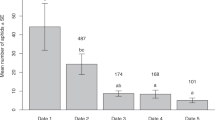The pea aphid, Acyrthosiphon pisum Harris (Hemiptera: Aphididae) is found in red and green color morphs. Previous work has suggested that the aphidiine parasitoid Aphidius ervi Haliday preferentially attacks green pea aphids in the field. It is not clear whether these results reflect a real preference, or some unknown clonal difference, such as in immunity, between the aphids used in the previous studies. We used three susceptibility-matched pairs of red and green morph pea aphid clones to test for preferences. In a no-choice situation, the parasitoids attacked equal proportions of each color morph. When provided with a choice, A. ervi was significantly more likely to oviposit into colonies formed from green morphs when the neighboring colony was formed from red morph aphids. In contrast, red morphs were less likely to be attacked when their neighboring colony was of the green morph. By preferentially attacking green colonies, A. ervi may reduce the likelihood of intraguild predation, as it is suggested that visually foraging predators preferentially attack red aphid colonies. Furthermore, if this host choice behavior is replicated in the field, we speculate that color morphs of the pea aphid may interact indirectly through their shared natural enemies, leading to intraspecific apparent competition.

Similar content being viewed by others
REFERENCES
Battaglia, D., Pennacchio, F., Romano, A., and Tranfaglia, A. (1995). The role of physical cues in the regulation of host recognition and acceptance behavior of Aphidius ervi Haliday (Hymenoptera: Braconidae). J. Insect. Behav. 8: 739–750.
Battaglia, D., Poppy, G., Powell, W., Romano, A., Tranfaglia, A., and Pennachio F. (2000). Physical and chemical cues influencing the oviposition behaviour of Aphidius ervi. Ent. Exp. Appl. 94: 219–227.
Brodeur, J., and Rosenheim, J. A. (2000). Intraguild interactions in aphid parasitoids. Ent. Exp. Appl. 97: 93–108.
Chaneton, E. J., and Bonsall, M. B. (2000). Enemy-mediated apparent competition: Empirical patterns and the evidence. Oikos 88: 380–394.
Du, Y., Poppy, G. M., Powell, W., and Wadhams, L. J. (1997). Chemically mediated associative learning in the host foraging behavior of the aphid parasitoid Aphidius ervi (Hymenoptera: Braconidae). J. Insect. Behav. 10: 509–522.
Fellowes, M. D. E., van Alphen, J. J. M., and Jervis, M. (2005). The foraging behaviour of insect natural enemies. In M. Jervis (ed.), Insects as Natural Enemies: A Practical Perspective, 2nd Edn., Dordrecht, Kluwer, pp. 1–71.
Ferrari, J., Müller, C. B., Kraaijeveld, A. R., and Godfray, H. C. J. (2001). Clonal variation and covariation in aphid resistance to parasitoids and a pathogen. Evolution 55: 1805–1814.
Gwynn, D. M., Callaghan, A., Gorham, J., Walters, K. F. A., and Fellowes, M. D. E. (2005). Resistance is costly: trade-offs between immunity, fecundity and survival in the pea aphid. Proc. R. Soc. Lond. B 272: 1803–1808.
Harmon, J. P., Losey, J. E., and Ives, A. R. (1998). The role of vision and color in the close proximity foraging behavior of four coccinellid species. Oecologia 115: 287–292.
Harrington, C. D. (1945). Biological races of the pea aphid. J. Econ. Entomol. 38: 12–22.
H enter, H. J., and Via, S. (1995). The potential for coevolution in a host-parasitoid system.1. Genetic variation within an aphid population in susceptibility to a parasitic wasp. Evolution 49: 427–438.
Hufbauer, R. A., and Via, S. (1999). Evolution of an aphid-parasitoid interaction: variation in resistance to parasitism among aphid populations specialized on different plants. Evolution 53: 1435–1445.
Li, S., Falabella, P., Giannantonio, S., Fanti, P., Battaglia, D., Digilio, M. C., Volkl, W., Sloggett, J. J., Weisser, W., and Pennacchio, F. (2002). Pea aphid clonal resistance to the endophagous parasitoid Aphidius ervi. J. Ins. Physiol. 48: 971–980.
Losey, J. E., Ives, A. R., Harmon, J., Ballantyne, F., and Brown, C. (1997). A polymorphism maintained by opposite patterns of parasitism and predation. Nature 388: 269–272.
Morris, R. J., and Fellowes, M. D. E. (2002). Learning and natal host influence host preference, handling time and sex allocation behaviour in a pupal parasitoids. Behav. Ecol. Sociobiol. 51: 386–393.
Oliver, K. M., Moran, N. A., and Hunter, M. S. (2005). Variation in resistance to parasitism in aphids is due to symbionts and not host genotype. Proc. Natl. Acad. Sci. USA 102: 12975–12800.
Oliver, K. M., Russell, J. A., Moran, N. A., and Hunter, M. S. (2003). Facultative bacterial symbionts in aphids confer resistance to parasitic wasps. Proc. Natl. Acad. Sci. USA 100: 1803–1807.
Shiojiri, K., and Takabayashi, J. (2005). Parasitoid preference for host-infested plants is affected by the risk of intraguild predation. J. Insect. Behav. 18: 567–576
Snyder, W. E., and Ives, A. R. (2001). Generalist predators disrupt biological control by a specialist parasitoid. Ecology 82: 705–716.
Sokal, R. R., and Rohlf., F. J. (1995). Biometry: The Principles and Practice of Statistics in Biological Research. 3rd Edn., New York, W. H. Freeman and Co.
Stacey, D. A., and Fellowes, M. D. E. (2002). Influence of temperature on pea aphid Acyrthosiphon pisum (Hemiptera: Aphididae) resistance to natural enemy attack. B. Entomol. Res. 92: 351–357.
Starý, P. (1962). Hymenopterous parasites of the pea aphid Acyrthosiphon onobrychis (Boyer) in Czechoslovakia. I. Bionomics and ecology of Aphidius ervi Haliday. Folia. Zoologica. 11: 265–279.
Author information
Authors and Affiliations
Corresponding author
Rights and permissions
About this article
Cite this article
Libbrecht, R., Gwynn, D.M. & Fellowes, M.D.E. Aphidius ervi Preferentially Attacks the Green Morph of the Pea Aphid, Acyrthosiphon pisum . J Insect Behav 20, 25–32 (2007). https://doi.org/10.1007/s10905-006-9055-y
Published:
Issue Date:
DOI: https://doi.org/10.1007/s10905-006-9055-y




